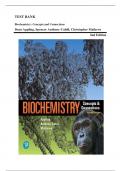TEST BANK
Biochemistry: Concepts and Connections
Dean Appling, Spencer Anthony-Cahill, Christopher Mathews
2nd Edition
M
ED
C
O
N
N
O
IS
SE
U
R
, Biochemistry: Concepts and Connections (Appling et al.)
Chapter 1 Biochemistry and the Language of Chemistry
1) The water content in the human body is approximately:
A) 90%.
M
B) 80%.
C) 70%.
D) 60%.
E) 50%.
ED
Answer: C
2) The four most abundant chemical elements in living systems are:
A) hydrogen, oxygen, sulfur and phosphorus.
B) hydrogen, carbon, nitrogen and oxygen.
C) sodium, potassium, carbon and oxygen.
C
D) sodium, potassium, nitrogen and sulfur.
E) carbon, nitrogen, oxygen and potassium.
O
Answer: B
Objective: 1.2
3) Nearly all proteins contain:
N
A) cobalt.
B) phosphorus.
C) selenium.
N
D) sulfur.
E) none of the above.
Answer: D
O
Objective: 1.2
Global LO: G7
IS
4) Which of the following statements is FALSE?
A) Proteins can be structural components of cells.
B) Proteins can transmit signals between cells.
C) Proteins can transport molecules within cells and between cells.
SE
D) Proteins can be both hormones and hormone receptors.
E) Proteins are the only biological polymer that can catalyze biochemical reactions.
Answer: E
Objective: 1.2
Global LO: G7
U
R
1
Copyright © 2018 Pearson Education, Inc.
, 5) Which of the following is NOT classed as a lipid?
A) Cholesterol
B) Palmitic acid
C) Glycerol
D) Phosphatidyl serine
M
E) Triacylglycerol
Answer: C
Objective: 1.2
Global LO: G7
ED
6) Amino acids and simple organic compounds like carbon dioxide and hydrogen cyanide cannot
be produced without the use of enzymes.
Answer: FALSE
Objective: 1.2
Global LO: G7
C
7) Oxidation-reduction reactions, which are the basis of many biochemical reactions and
pathways, cannot take place in the absence of oxygen.
O
Answer: FALSE
Objective: 1.2
Global LO: G7
N
8) Many biochemical reactions that form biopolymers from monomeric units involve the
removal of water.
N
Answer: TRUE
Objective: 1.2
Global LO: G7
O
9) The principle component of a biological membrane is a triglyceride.
Answer: FALSE
IS
Objective: 1.2
Global LO: G7
10) The chemical element has a role in both transfer of energy as well as in the
SE
structure of nucleic acids.
Answer: phosphorus
Objective: 1.2
Global LO: G7
U
11) List the four major classes of biological macromolecules.
Answer: lipids, carbohydrates, proteins, nucleic acids
Objective: 1.2
R
Global LO: G7
2
Copyright © 2018 Pearson Education, Inc.
, 12) An amphipathic molecule provides the foundation for biological membranes because they
have both and functional groups.
Answer: hydrophobic, hydrophilic
Objective: 1.2
Global LO: G7
M
13) Genomics is concerned with the entire , while is focused on identifying
all of the proteins of a cell.
Answer: genome, proteomics
ED
Objective: 1.5
Global LO: G1
C
O
N
N
O
IS
SE
U
R
3
Copyright © 2018 Pearson Education, Inc.




